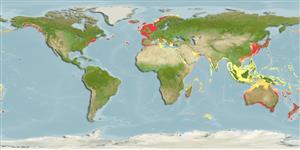Common names from other countries
Environment: milieu / climate zone / depth range / distribution range
Sinh thái học
Tầng nổi; Mức độ sâu 0 - 250 m (Ref. 1134). Subtropical; 7°C - 30°C (Ref. 1134)
Atlantic, the Mediterranean and Indo-Pacific. Tropical to temperate.
Length at first maturity / Bộ gần gũi / Khối lượng (Trọng lượng) / Age
Maturity: Lm ? range ? - ? cm Max length : 60.0 cm COLD con đực/không giới tính; (Ref. 1610)
Minimum depth from Ref. 116065. Marine, planktonic; most plentiful below 250 m (Ref. 1134). Filter-feeder. Forms blooms (Ref. 130729).
Life cycle and mating behavior
Chín muồi sinh dục | Sự tái sinh sản | Đẻ trứng | Các trứng | Sự sinh sản | Ấu trùng
Members of the order Pyrosomatida includes clonal and sexual phases in its life cycle. Life cycle: Eggs develop into lecithotrophic oozooid (cyathozooid) which undergo budding to form four blastozooids. The oozoid degenerates and the colony is formed from the blastozooids.
Kott, P. 2005. (Ref. 1134)
IUCN Red List Status (Ref. 130435)
CITES status (Ref. 108899)
Not Evaluated
Not Evaluated
Human uses
| FishSource |
Các công cụ
Thêm thông tin
Age/Size
Sự sinh trưởng
Length-weight
Length-length
Hình thái học
Ấu trùng
Sự phong phú
Các nguồn internet
Estimates based on models
Vulnerability
Moderate vulnerability (44 of 100).
Price category
Unknown.
